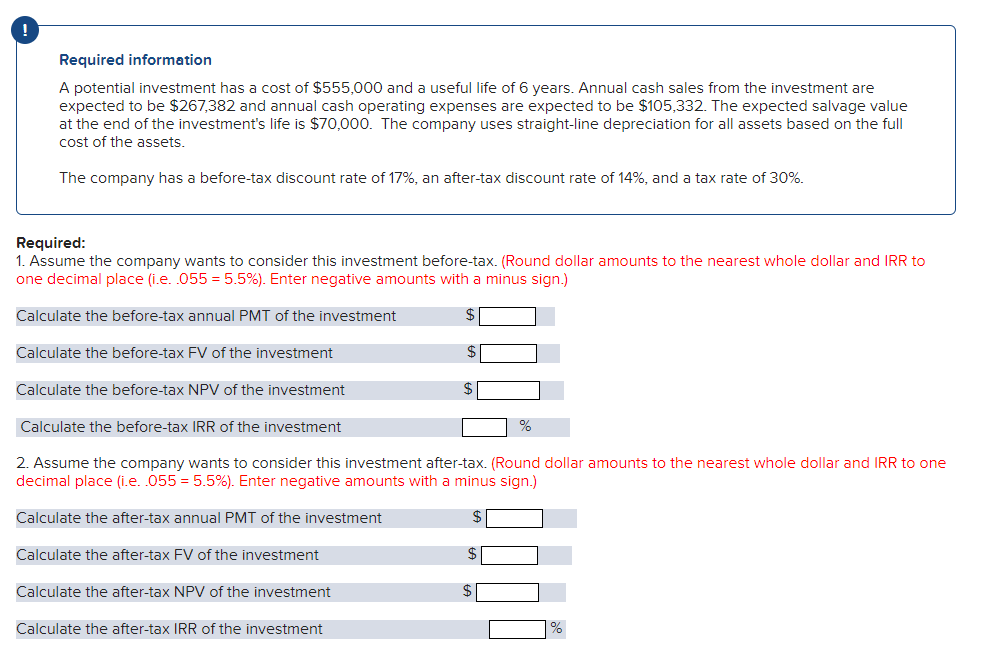Required information A potential investment has a cost of $555,000 and a useful life of 6 years. Annual cash sales from the investment are expected to be $267,382 and annual cash operating expenses are expected to be $105,332. The expected salvage value at the end of the investment's life is $70,000. The company uses straight-line depreciation for all assets based on the full cost of the assets. The company has a before-tax discount rate of 17%, an after-tax discount rate of 14%, and a tax rate of 30%. Required: 1. Assume the company wants to consider this investment before-tax. (Round dollar amounts to the nearest whole dollar and IRR to one decimal place (i.e. .055 = 5.5%). Enter negative amounts with a minus sign.) Calculate the before-tax annual PMT of the investment Calculate the before-tax FV of the investment Calculate the before-tax NPV of the investment Calculate the before-tax IRR of the investment 2. Assume the company wants to consider this investment after-tax. (Round dollar amounts to the nearest whole dollar and IRR to one decimal place (i.e. 055 = 5.5%). Enter negative amounts with a minus sign.) Calculate the after-tax annual PMT of the investment Calculate the after-tax FV of the investment Calculate the after-tax NPV of the investment Calculate the after-tax IRR of the investment |% DOOD %24 %24 %24 %24 %24 %24
Required information A potential investment has a cost of $555,000 and a useful life of 6 years. Annual cash sales from the investment are expected to be $267,382 and annual cash operating expenses are expected to be $105,332. The expected salvage value at the end of the investment's life is $70,000. The company uses straight-line depreciation for all assets based on the full cost of the assets. The company has a before-tax discount rate of 17%, an after-tax discount rate of 14%, and a tax rate of 30%. Required: 1. Assume the company wants to consider this investment before-tax. (Round dollar amounts to the nearest whole dollar and IRR to one decimal place (i.e. .055 = 5.5%). Enter negative amounts with a minus sign.) Calculate the before-tax annual PMT of the investment Calculate the before-tax FV of the investment Calculate the before-tax NPV of the investment Calculate the before-tax IRR of the investment 2. Assume the company wants to consider this investment after-tax. (Round dollar amounts to the nearest whole dollar and IRR to one decimal place (i.e. 055 = 5.5%). Enter negative amounts with a minus sign.) Calculate the after-tax annual PMT of the investment Calculate the after-tax FV of the investment Calculate the after-tax NPV of the investment Calculate the after-tax IRR of the investment |% DOOD %24 %24 %24 %24 %24 %24
Chapter11: Long-term Assets
Section: Chapter Questions
Problem 13PA: Colquhoun International purchases a warehouse for $300,000. The best estimate of the salvage value...
Related questions
Concept explainers
Depreciation Methods
The word "depreciation" is defined as an accounting method wherein the cost of tangible assets is spread over its useful life and it usually denotes how much of the assets value has been used up. The depreciation is usually considered as an operating expense. The main reason behind depreciation includes wear and tear of the assets, obsolescence etc.
Depreciation Accounting
In terms of accounting, with the passage of time the value of a fixed asset (like machinery, plants, furniture etc.) goes down over a specific period of time is known as depreciation. Now, the question comes in your mind, why the value of the fixed asset reduces over time.
Topic Video
Question

Transcribed Image Text:Required information
A potential investment has a cost of $555,000 and a useful life of 6 years. Annual cash sales from the investment are
expected to be $267,382 and annual cash operating expenses are expected to be $105,332. The expected salvage value
at the end of the investment's life is $70,000. The company uses straight-line depreciation for all assets based on the full
cost of the assets.
The company has a before-tax discount rate of 17%, an after-tax discount rate of 14%, and a tax rate of 30%.
Required:
1. Assume the company wants to consider this investment before-tax. (Round dollar amounts to the nearest whole dollar and IRR to
one decimal place (i.e. .055 = 5.5%). Enter negative amounts with a minus sign.)
Calculate the before-tax annual PMT of the investment
Calculate the before-tax FV of the investment
$
Calculate the before-tax NPV of the investment
$
Calculate the before-tax IRR of the investment
2. Assume the company wants to consider this investment after-tax. (Round dollar amounts to the nearest whole dollar and IRR
one
decimal place (i.e. .055 = 5.5%). Enter negative amounts with a minus sign.)
Calculate the after-tax annual PMT of the investment
Calculate the after-tax FV of the investment
2$
Calculate the after-tax NPV of the investment
Calculate the after-tax IRR of the investment
Expert Solution
This question has been solved!
Explore an expertly crafted, step-by-step solution for a thorough understanding of key concepts.
Step by step
Solved in 3 steps with 10 images

Knowledge Booster
Learn more about
Need a deep-dive on the concept behind this application? Look no further. Learn more about this topic, finance and related others by exploring similar questions and additional content below.Recommended textbooks for you

Principles of Accounting Volume 1
Accounting
ISBN:
9781947172685
Author:
OpenStax
Publisher:
OpenStax College

Managerial Accounting
Accounting
ISBN:
9781337912020
Author:
Carl Warren, Ph.d. Cma William B. Tayler
Publisher:
South-Western College Pub


Principles of Accounting Volume 1
Accounting
ISBN:
9781947172685
Author:
OpenStax
Publisher:
OpenStax College

Managerial Accounting
Accounting
ISBN:
9781337912020
Author:
Carl Warren, Ph.d. Cma William B. Tayler
Publisher:
South-Western College Pub


Excel Applications for Accounting Principles
Accounting
ISBN:
9781111581565
Author:
Gaylord N. Smith
Publisher:
Cengage Learning

Financial Reporting, Financial Statement Analysis…
Finance
ISBN:
9781285190907
Author:
James M. Wahlen, Stephen P. Baginski, Mark Bradshaw
Publisher:
Cengage Learning

Cornerstones of Financial Accounting
Accounting
ISBN:
9781337690881
Author:
Jay Rich, Jeff Jones
Publisher:
Cengage Learning